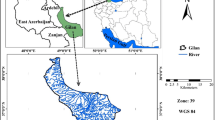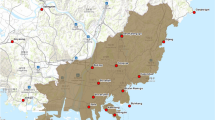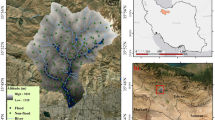Abstract
Machine learning (ML) algorithms are reliable approaches to address incomplete datasets in existing studies. In this study, the ML algorithms naïve Bayes (NB) and random forest (RF) were used to generate a flash flood forecasting model in Wadi El-Dib on the Gulf of Suez Coast at the Eastern Desert of Egypt. A total of 1117 point locations of field data and remote sensing data were mapped to prepare a flood inventory map. The relationships between the flood controlling factors were assessed and evaluated based on the implemented approaches. Slope degree, distance from streams, topographic wetness index, and elevation are the most important controlling factors out of the input seven themes. The proposed prediction model for the identification of flooding and nonflooding areas achieved reliable accuracy for the implemented approaches according to the area under the curve. Results demonstrate that the flash flood model was able to simulate flooding and nonflooding areas with improved accuracy. The NB and RF models achieved predictive performance with an accuracy of 85% to 88%, respectively. The susceptibility map was classified into flooding zones and nonflooding zones, which might be helpful for urbanization planning and management. Our findings indicate that about 83% of the field data were plotted into susceptible flooding zones and that eastern areas with gentle slopes have high potential for flash floods. ML can extract and generate useful information, and related models could be applied in such studies and similar areas.







Similar content being viewed by others
References
Abdollahi S, Pourghasemi HR, Ghanbarian GA, Safaeian R (2019) Prioritization of effective factors in the occurrence of land subsidence and its susceptibility map** using an SVM model and their different kernel functions. Bull Eng Geol Environ 78(6):4017–4034. https://doi.org/10.1007/s10064-018-1403-6
Abu El Magd SA, Orabi HO, Ali SK, Farhana Parvin P, Pham QB (2021) An integrated approach for evaluating the flash flood risk and potential erosion using the hydrologic indices and morpho tectonic parameters. Environ Earth Sci 80:694. https://doi.org/10.1007/s12665-021-10013-0
Abu El-Magd SA, Sk A, Pham QB (2021b) Spatial modeling and susceptibility zonation of landslides using random forest, naïve bayes and K-nearest neighbor in a complicated terrain. Earth Sci Inform. https://doi.org/10.1007/s12145-021-00653-y
Abu El-Magd SA, Amer RA, Embaby A (2020) Multi-criteria decision-making for the analysis of flash floods: a case study of Awlad Toq-Sherq, Southeast Sohag, Egypt. J Afr Earth Sci 162
Abu El-Magd SA, Pradhan B, Alamri A (2021c) Machine learning algorithm for flash flood prediction map** in Wadi El-Laqeita and surroundings, central Eastern Desert. Egypt. Arab J Geosci
Ashmawy MH (1994) Assessment of flash flood potential of the Red Sea drainage basins along the Qena Safaga highway, Eastern Desert, Egypt. ITC J 2:119128
Bernard S, Heutte L, Adam S (2009) Influence of hyperparameters on random forest accuracy. In MCS, vol. 5519 of Lecture Notes in Computer Science (pp. 171–180)
Breiman L (2001) Random forests. Mach Learn 45(1):5–32. https://doi.org/10.1023/A:1010933404324
Chen C, Hardle W, Unwin A, Cox MAA, Cox TF (2008) Multidimensional scaling. Handbook of data visualization. Springer, Berlin Heidelberg, pp 315–347. https://doi.org/10.1007/978-3-540-33037-0_14
Chen W, **e X, Wang J, Pradhan B, Hong H, Bui DT, Ma J (2017) A comparative study of logistic model tree, random forest, and classification and regression tree models for spatial prediction of landslide susceptibility. Catena 151:147–160. https://doi.org/10.1016/J.CATENA.2016.11.032
Conoco Coral Corporation (1988) Geological map of Egypt, scale 1: 500,000 - NG 36 NE Qusseir. The Egyptian General Petroleum Corporation, 1 map
Ei-meliegy A, El-shayeb M, Meleik L, Abdel-Raheim M (2000) Surface delineation of lithologies and nomalies, Wadi Dib Area, Eastern Desert, Egypt, using aeroradiospectrometric survey data. Sci J Fac Sci Minujiya Univ VoL XIC 2000:179–231
El-Gaby S, List F K, Tehrani R (1988) Geology, evaluation and metallogenesis of the Pan-Aliican Belt in Egypt, in the Pan-Afiican Belt of Northeast Aliica and adjacent areas. Ed. by S. El-Gaby and R. 0. Greilling, pp. 17–68, Friedr. Vieweg, Braunschweig
El-Gaby S, List F K, Tehreni R (1990) The basement complex of the Eastern Desert and Sinai: In the geology of Egypt. Ed. By Said, R., Published by Ballcema, A. A., Rotterdam, Netherlands, pp. 175–181
Feng C, Wang Y C (2011) GIScience research challenges for emergency management in Southeast Asia. Natural Hazards 59, 597616. Available from: https://doi.org/10.1007/s11069-011-9778-8
Friedman JH, Meulman JJ (2003) Multiple additive regression trees with application in epidemiology. Stat Med 22:1365–1381
Ghorbanzadeh O, Valizadeh K, Blaschke T, Aryal J, Naboureh A, Einali J, Bian J (2019) Spatial prediction of wildfire susceptibility using field survey GPS data and machine learning approaches. Fire 2(3), 43. https://doi.org/10.3390/fre2030043
Golkarian A, Naghibi SA, Kalantar B, Pradhan B (2018) Groundwater potential map** using C5.0, random forest, and multivariate adaptive regression spline models in GIS. Environ Monit Assess 190(3):149. https://doi.org/10.1007/s10661-018-6507-8
Jeong J, Park E (2019) Comparative applications of data-driven models representing water table fluctuations. J Hydrol 572:261–273
Mohammady M, Pourghasemi HR, Amiri M (2019) Land subsidence susceptibility assessment using random forest machine learning algorithm. Environ Earth Sci 78(16):503. https://doi.org/10.1007/s12665-019-8518-3
Naghibi SA, Ahmadi K, Daneshi A (2017) Application of support vector machine, random forest, and genetic algorithm optimized random forest models in groundwater potential map**. Water Resour Manag 31(9):2761–2775. https://doi.org/10.1007/s11269-017-1660-3
Park S, Kim J (2019) Landslide susceptibility map** based on random forest and boosted regression tree models, and a comparison of their performance. Appl Sci 9(5):942. https://doi.org/10.3390/app9050942
Pradhan B (2010) Flood susceptible map** and risk area delineation using logistic regression, GIS, and remote sensing. J Spat Hydrol 9(2):1–18
Probst P, Boulesteix AL (2017) To tune or not to tune the number of trees in a random forest? J Mach Learn Res 18:1–18
Provost F, Fawcett T, Kohavi R (1998) The case against accuracy estimation for comparing induction algorithms. In: Shavlik, J. (Ed.), Proc. ICML-98. Morgan Kaufmann, San Francisco, CA, pp. 445–453.
Rahmati O, Falah F, Naghibi SA, Biggs T, Soltani M, Deo RC, Tien Bui D (2019) Land subsidence modelling using tree-based machine learning algorithms. Sci Total Environ 672:239–252. https://doi.org/10.1016/j.scitotenv.2019.03.496
Rahmati O, Pourghasemi HR (2017) Identification of critical flood prone areas in data-scarce and ungauged regions: a comparison of three data mining models. Water Resour Manag 31(5), 1473–1487. Available from: https://doi.org/10.1007/s11269-017-1589-6
Rebala G, Ravi A, Churiwala S (2019) An introduction to machine learning. Chapter 7) in book. https://doi.org/10.1007/978-3-030-15729-6_7
Scornet E (2018) Tuning parameters in random forests. ESAIM: Proc Surv 60:144–162
Sheng** Y, Gilbert B (2017) The receiver operating characteristic (ROC) curve. Southwest Respir Crit Care Chronicles 5(19):34–36
Strahler A (1957) Quantitative analysis of watershed Geomorphology. Eos Transactions on AGU 38(6):913–920
Taalab K, Cheng T, and Zhang Y (2018) Map** landslide susceptibility and types using Random Forest. Big Earth Data 2 (2): 159–178. https://doi.org/10.1080/20964471.2018.1472392
Tehrany MS, Jones S, Shabani F, Martínez-Alvarez F, Tien Bui D (2019) A novel ensemble modeling approach for the spatial prediction of tropical forest fire susceptibility using LogitBoost machine learning classifier and multi-source geospatial data. Theor Appl Climatol 137(1–2):637–653. https://doi.org/10.1007/s00704-018-2628-9
Tehrany MS, Pradhan B, Mansor S, Ahmad N (2015) Flood susceptibility map** using GIS-based support vector machine model with different kernel types. Catena 125(91):101. https://doi.org/10.1016/j.CATENA.2014.10.017
Wright MN, Ziegler A, König IR (2016) Do little interactions get lost in dark random forests? BMC Bioinform 17:145
Yaseen ZM, Jaafar O, Deo RC, Kisi O, Adamowski J, Quilty J, ElShafie A (2016) Stream-flow forecasting using extreme learning machines: a case study in a semi-arid region in Iraq. J Hydrol 542:603–614
Youssef A M, Abdel Moneim A A, Abu El-Maged S A (2005) Flood hazard assessment and its associated problems using geographic information systems, Sohag Governorate, Egypt. The Fourth International Conference on the Geology of Africa (pp. 117). Assiut, Egypt
Youssef AM, Hegab M (2019) Flood-hazard assessment modeling using multicriteria analysis and GIS: a case study—Ras Gharib Area, Egypt spatial modeling in GIS and R for earth and environmental sciences. Book chapter (Ch10). https://doi.org/10.1016/B978-0-12-815226-3.00010-7
Youssef AM, Pradhan B, Hassan A M (2010) Flash flood risk estimation along the St. Katherine Road, Southern Sinai, Egypt Using GIS Based Morphometry and Satellite Imager. Environ Earth Sci 62(3), 611623. Available from: https://doi.org/10.1007/s12665-010-0551-1
Youssef AM, Pradhan B, Sefry SA (2016a) Flash flood susceptibility assessment in Jeddah city (Kingdom of Saudi Arabia) using bivariate and multivariate statistical models. Environ Earth Sci 75, 12. Available from: https://doi.org/10.1007/s12665-015-4830-8
Youssef AM, Sefry SA, Pradhan B, Al Fadail EA (2016b) Analysis on causes of flash flood in Jeddah city (Kingdom of Saudi Arabia) of 2009 and 2011 using multi-sensor remote sensing data and GIS. Geomatics Nat Hazards Risk, 7(3), 1018-1042. https://doi.org/10.1080/19475705.2015.1012750
Acknowledgment
The author is grateful for the insightful comments of the editor and an anonymous reviewer.
Data availability
Data and materials are available upon request.
Code availability
R and QGIS are open-source packages used in this work.
Author information
Authors and Affiliations
Corresponding author
Ethics declarations
Conflict of interest
The author declare no competing interests.
Additional information
Responsible Editor: Broder J. Merkel
Rights and permissions
About this article
Cite this article
Abu El-Magd, S.A. Random forest and naïve Bayes approaches as tools for flash flood hazard susceptibility prediction, South Ras El-Zait, Gulf of Suez Coast, Egypt. Arab J Geosci 15, 217 (2022). https://doi.org/10.1007/s12517-022-09531-3
Received:
Accepted:
Published:
DOI: https://doi.org/10.1007/s12517-022-09531-3




